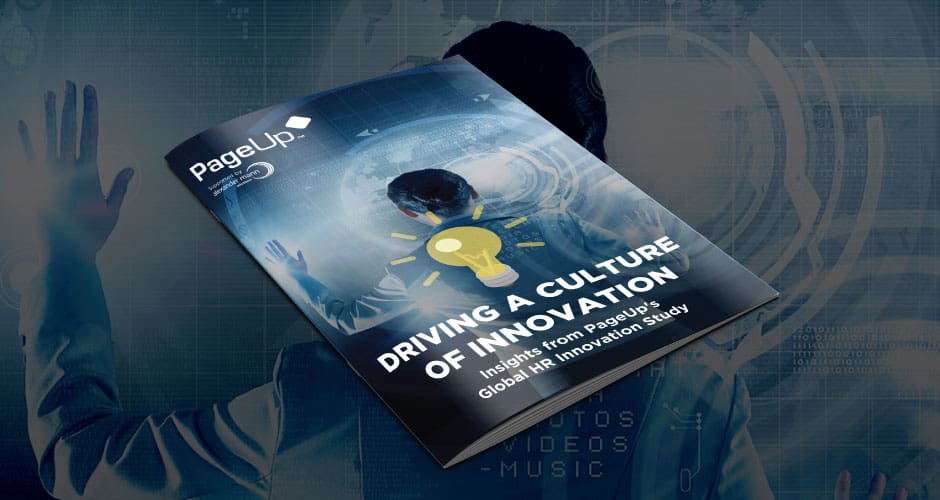Innovation is the holy grail of business. It’s a quest for products and services that delight customers and lead to sustainable competitive advantage. Many companies want to establish a culture of innovation – one that will encourage flexibility, creativity and support risk-taking. The benefit? Breakthrough products, a superior customer experience and an agile response to market challenges. The most effective innovation strategies focus on people and talent management practices, placing HR in a unique position to enhance (or hinder) innovative behaviours and practices within an organisationorganization. Trust, inclusiveness, willingness to take risks and established processes to commercialisecommercialize ideas, are all necessary for innovation to thrive.
But what is happening in organisationsorganizations today, and what is HR’s role in not only supporting, but also driving, a culture of innovation? PageUp conducted a Global HR Innovation Survey, in partnership with Alexander Mann Solutions, investigating:
- where companies are placed on their journey to creating a culture of innovation,
- the effectiveness of current talent management practices in driving and supporting innovation, and
- how prepared HR is to meet the future talent needs of the business.
Our research highlights seven big picture trends:
1. Culture: More than corporate values, it’s how we do things around here.
A sustainable culture of innovation requires organisationorganization-wide commitment. It must be driven from the top-down. Executives, managers and people leaders all have a role to play to endorse creativity, idea-sharing and collaboration. Although most organisationsorganizations encouraged creativity and innovation as a corporate value, for many it wasn’t underpinned by other aspects required to create a thriving culture of innovation. Absent for many was a culture that promoted risk-taking and entrepreneurial behaviour, and an environment of trust in which employees could challenge existing assumptions, try new ideas, and fail.
2. Framework, process and technology underpin company-wide innovation.
Innovation can happen in an ad hoc, siloed manner or become an organisationorganization-wide phenomenon. Democratising innovation requires widespread use of technology and structured processes. We found companies were more likely to have adopted technology than to have established processes – yet both are needed. Technology facilitates collaboration and knowledge sharing, and reduces barriers to entry.
Nearly two-thirds of organisationsorganizations are using digital, social, collaborative, mobile and data technologies to support innovation.
Nearly two-thirds of organisationsorganizations are using digital, social, collaborative, mobile and data technologies to support innovation. In contrast, less than 40% of the respondents had established processes for prioritising ideas and just over half seek and incorporate feedback to improve outcomes. Without frameworks for developing, prioritising and refining, companies will struggle to scale and commercialisecommercialize ideas, potentially foregoing growth opportunities.
3. HR has a role to play in driving innovation…but is not delivering.
Driving innovation in the next 12 months is an organisationalorganizational priority for nearly two-thirds of companies. HR is more confident than its non-HR peers that it has a role to play in this. The challenge for HR is to shift the perception of its value proposition – nearly half of non-HR professionals think HR currently adds no, or negative value, in driving innovation. Even within organisationsorganizations where innovation is a top priority HR is not as effective as it could be. HR needs to work hard to close this perceived gap and remain relevant.
Focus and determination are required to ensure HR delivers the strategic value it inherently holds.
4. Recruitment, move beyond diversity to building future workforce capability.
Of all the aspects measured, diversity practices scored the highest for HR effectiveness. Two-thirds of companies promote diversity of thought and have established practices for creating a diverse and inclusive culture. But companies need to move beyond talent acquisition strategies focused on diversity, to future-proofing the workforce.
Two-thirds of companies promote diversity of thought and have established practices for creating a diverse and inclusive culture.
Despite the ongoing competition for talent and concerns of skill shortages, strategies to build workforce capability were less established than expected. A focused approach to acquiring talent with the skills, attitude and behaviours needed to drive innovation is still required for many organisationsorganizations.
5. Performance management – more than reward and recognition.
Recognising and rewarding innovation is key to establishing a culture of innovation. There was a mismatch between the number of organisationsorganizations that say they recogniserecognize and reward innovation, and those with established performance management practices for doing so. This suggests that companies are willing to adopt innovative processes without the support of HR. Innovation cannot be truly optimisedoptimized without ongoing, iterative feedback. Despite a market shift in emphasis from annual performance reviews to continuous feedback, the majority of companies aren’t there yet.
6. Learning and development – building innovation capability.
A sustainable culture of innovation has everyone innovating. Company-wide capability requires training in innovative thinking processes and frameworks. Very few companies had established practices in place to support the development of such skills. This represents a huge opportunity for HR. Additionally, although knowledge sharing and collaborative work practices were well established for over half the respondents, established development practices to support a cross-functional approach were more limited.
7. Future-proofing your workforce – the role of talent mobility.
Moving beyond traditional succession management, talent mobility is critical to HR’s ability to dynamically develop and align the current and future workforce to strategic business needs. Yet, this was the area in which HR had the least traction. Leaders are being developed to drive company-wide innovation – but not necessarily through HR-led initiatives. The ability to quickly bring together high functioning teams is a hallmark of innovative companies. HR had limited traction in this area – established processes for moving talent between roles and visibility into current skill gaps are areas where HR should focus to create credibility and drive future value to the business. To explore these trends and other findings in more depth,
Fresh insights for HR
Stay up to date with HR trends, tips and more when you sign up for our industry newsletter






